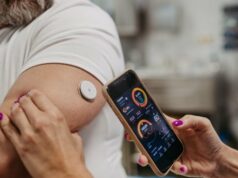Sensors can be a sticky subject for some people with diabetes. As wondrous as modern technology is, sometimes sensors can come off, and there can be any number of reasons for this. Ultimately though staying away from door frames has never been more important!
Whether you use the FreeStyle Libre, Dexcom G6 or another type of flash or continuous glucose monitor (CGM), it can help to have some tips to prevent your sensor falling off.
These are general tips and not specific to any device, and if you are still unsure about why or what could cause your sensor to fall off then visit your doctor for more information.
1. Plan your site changes
Try to plan your site change so that you can thoroughly wash the new site in advance. If you can, after removing your old sensor, wash both the old site thoroughly to remove any adhesive then wash the new site too. If you are out and unable to shower then wash your hands with soap and water, as well as the area you plan to hold your new sensor or infusion set. Make sure the area of skin is dry after washing.
2. Always clean the skin
It’s an obvious tip, but a really important one. Before inserting the sensor, clean your skin with antibacterial solution such as an alcoholic wipe (these may be provided with the sensor). Make sure, however, you do not insert the sensor until the cleaned area is dry. Not only does using antibacterial wipes help the sensor adhesive to stick better but it will also help to prevent infection.
3. Tape it up
If your patch is peeling up, use medical or overlay tape for extra support. Make sure to tape over all sides. Certain tapes may be suited to some better than others – anecdotal diabetes community tales refer to the irritability that can result from some tapes – so if this tip is for you then you might want to trial and error with which tape works best for you.
Be careful not to tape under the sensor pod where it could interfere with your readings.
4. Avoid body lotion
If you use skin oils or body lotions then be careful not to use them around the area of insertion. Skin oils can make it harder for the sensor to attach, and can also prevent any tape you may use from sticking on top of the sensor.
5. Alternate site locations
Alternating sensor locations is something worth taking the time to think about. For example, if you know you have a couple of physical activities approaching, you could try positioning the sensor somewhere more hidden. Alternating areas is also useful for gauging where the sensor is most comfortable for you. Sensors can also be placed on other body parts such as the torso, bottom, stomach or legs – but this may depend on your device and its instructions.
As I mentioned earlier, door frames are the enemy of sensors. If you find hinges are ripping your sensor, alternating your sensor location accordingly can help to reduce the risk of you bumping into something and tearing it off.
Still feeling nervous regarding your sensor?
In 2014, US researchers exploring skin and adhesive issues with CGMs wrote [1]:
“Achieving satisfactory adhesion of the CGM sensor and transmitter may involve finding the right supplemental product or combination of products through trial and error. Optimizing adhesion and minimizing skin irritation can significantly improve duration of use and tolerability of CGM devices by young children.”
It can take some time for some to feel confident that their sensor is secured, but remember that accidents can happen and sometimes even the best planning can come undone.
Using these tips can help to limit the incidences where your sensor won’t stick, but don’t hesitate to contact your device’s manufacturer or your doctor for more guidance.
References:
[1] Skin and Adhesive Issues With Continuous Glucose Monitors. 2014. [ONLINE] Available at: https://www.ncbi.nlm.nih.gov/pmc/articles/PMC4764227/. [Accessed 07 August 2019].








